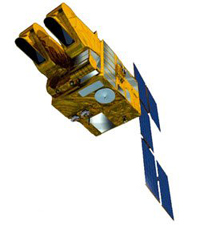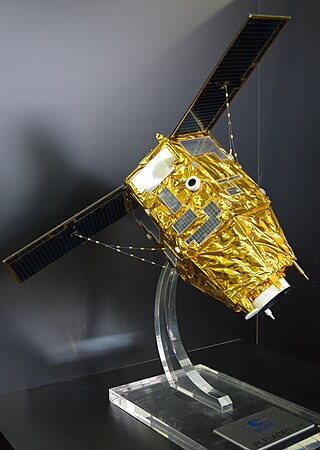Related Research Articles

SPOT is a commercial high-resolution optical Earth imaging satellite system operating from space. It is run by Spot Image, based in Toulouse, France. It was initiated by the CNES in the 1970s and was developed in association with the SSTC and the Swedish National Space Board (SNSB). It has been designed to improve the knowledge and management of the Earth by exploring the Earth's resources, detecting and forecasting phenomena involving climatology and oceanography, and monitoring human activities and natural phenomena. The SPOT system includes a series of satellites and ground control resources for satellite control and programming, image production, and distribution. Earlier satellites were launched using the European Space Agency's Ariane 2, 3, and 4 rockets, while SPOT 6 and SPOT 7 were launched by the Indian PSLV.
The Helios 2 system, which consists of the Helios 2A and Helios 2B, is a French-developed military Earth observation satellite program. Financed at 90% by France, the development also involved minor participation from Belgium, Spain, Italy and Greece. Helios 2A was launched on December 18, 2004, by an Ariane 5 rocket from French Guiana.

Space Technology 5 (ST5) of the NASA New Millennium program was a test of ten new technologies aboard a group of microsatellites. Developed by NASA Goddard Space Flight Center, the three individual small spacecraft were launched together from the belly of a Lockheed L-1011 aboard the Pegasus XL rocket, on 22 March 2006. One technology involved antennas that were designed by computers using an evolutionary AI system developed at NASA Ames Research Center. The ST5 on-board flight computer, the C&DH system, was based on a Mongoose-V radiation-hardened microprocessor.
Astrium was an aerospace manufacturer subsidiary of the European Aeronautic Defence and Space Company (EADS) that provided civil and military space systems and services from 2006 to 2013. In 2012, Astrium had a turnover of €5.8 billion and 18,000 employees in France, Germany, the United Kingdom, Spain and the Netherlands. Astrium was a member of Institute of Space, its Applications and Technologies.
PROTEUS is a 3-axis stabilized platform designed for mini-satellites weighing approximately 500 kg operating in low Earth orbit. The platform is used by six scientific satellites developed as part of the space program of the National Center for Space Studies (CNES) for the European Space Agency: Jason-1, 2 and 3, CALIPSO, CoRoT, and SMOS. The platform is developed by the satellite division of Aérospatiale.

Alphabus is a family of heavy geostationary communications satellites developed by a joint venture between Thales Alenia Space and EADS Astrium Satellites in France, with support of the Centre national d'études spatiales (CNES), the French space agency and the European Space Agency (ESA).
PICARD is a satellite dedicated to the simultaneous measurement of the absolute total and spectral solar irradiance, the diameter and solar shape, and to the Sun's interior probing by the helioseismology method. These measurements obtained throughout the mission allow study of their variations as a function of solar activity. It launched, along with the Prisma spacecraft, on 15 June 2010 on a Dnepr launcher from Dombarovskiy Cosmodrome, near Yasny, Russia. The mission, originally planned for two years, ended on 4 April 2014.
Essaim was a French military reconnaissance microsatellite constellation. Its main purpose was to collect and map signals intelligence around the world. The Direction générale de l'armement (DGA) described it as a "vacuum cleaner for [radio] waves".

The Pléiades constellation is composed of two very-high-resolution optical Earth-imaging satellites. Pléiades-1A and Pléiades-1B provide the coverage of Earth's surface with a repeat cycle of 26 days. Designed as a dual civil/military system, Pléiades will meet the space imagery requirements of European defence as well as civil and commercial needs.

The Satellite System for Terrestrial Observation, Sistema Satelital para Observación de la Tierra (SSOT), also known as FASat-Charlie, is a Chilean satellite which was launched on December 16, 2011. The objective of the SSOT is to have a satellite system for the observation of Earth based on international cooperation.
SSETI Express was the first spacecraft to be designed and built by European students and was launched by the European Space Agency. SSETI Express is a small spacecraft, similar in size and shape to a washing machine. On board the student-built spacecraft were three CubeSat picosatellites, extremely small satellites weighing around one kg each. These were deployed one hour and forty minutes after launch. Twenty-one university groups, working from locations spread across Europe and with very different cultural backgrounds, worked together via the internet to jointly create the satellite. The expected lifetime of the mission was planned to be 2 months. SSETI Express encountered an unusually fast mission development: less than 18 months from kick-off in January 2004 to flight-readiness.
Eurostar is a satellite bus made by Airbus Defence and Space (formerly Astrium, and before 1994, British Aerospace, and Matra Marconi Space which has been used for a series of spacecraft providing telecommunications services in geosynchronous orbit. More than 70 Eurostar satellites have been ordered to date, of which more than 55 have been successfully launched since October 1990 and have proven highly reliable in operational service. In December 2013, the Eurostar satellites accumulated 500 years of successful operations in orbit. The Eurostar spacecraft series is designed for a variety of telecommunications needs including fixed services and broadcast, mobile services, broadband and secured communications.
ELISA is a suite of four French military satellites launched on 17 December 2011 from Arianespace's Kourou spaceport in French Guiana. It consists of microsatellites ELISA 1, ELISA 2, ELISA 3, and ELISA 4

Aldebaran is a proposed air-launched microsatellite launch vehicle testbed studied by CDTI, CNES and DLR for a future launcher capable of lifting up to 300 kilograms (660 lb) into Low Earth Orbit.
Sodern is a French company based in Limeil-Brévannes, near Paris in Ile-de-France, specialized in space instrumentation, optics and neutron analyzers.
Airbus Defence and Space is the division of Airbus SE responsible for the development and manufacturing of the corporation's defence and space products, while also providing related services. The division was formed in January 2014 during the corporate restructuring of European Aeronautic Defence and Space (EADS), and comprises the former Airbus Military, Astrium, and Cassidian divisions. It is the world's second-largest space company after Boeing and one of the top ten defence companies in the world.

Vegetation and Environment monitoring on a New Micro-Satellite (VENµS) is a near polar sun-synchronous orbit microsatellite. It is a joint project of the Israeli Space Agency and CNES. The project was signed upon in April 2005 and was launched on the 2nd of August 2017. The microsatellite, which was set to cost the ISA US$20 million and CNES €10 million, was designed and built by IAI and Rafael under ISA's supervision.
The Micro-Satellite à traînée Compensée pour l'Observation du Principe d'Equivalence is a 300-kilogram (660 lb) class minisatellite operated by CNES to test the universality of free fall with a precision to the order of 10−15, 100 times more precise than can be achieved on Earth. It was launched on 25 April 2016 alongside Sentinel-1B and other small satellites, and was decommissioned around 18 October 2018 after completion of its science objectives. The final report was published in 2022.
The National Space Program (PSN) horizons 2020 planned to put in place space infrastructures, space systems and increase the specialized human resources in space technologies. Among the space systems planned in the PSN are Algeria's satellites, of which a significant number should be partly or totally integrated in the Algerian center for satellite development "CDS". CDS offers the technological environment for national competence to develop the future Algerian satellite systems. Algeria's objectives is to make of space tools a powerful instrument in national prosperity in the fields of earth observation, meteorology and communications.
TARANIS was an observation satellite of the French Space Agency (CNES) which would have studied the transient events produced in the Earth's atmospheric layer between 10 km (6.2 mi) and 100 km (62 mi) altitude. TARANIS was launched in November 2020 with SEOSat-Ingenio aboard Vega flight VV17 and would have been placed in a sun-synchronous orbit at an altitude of 676 km, for a mission duration of two to four years, but the rocket failed shortly after launch.
References
- eoPortal directory: Myriade (CNES Microsatellite Program)
- Tatry, B.; Claire, M.-A. (November 2004). Warmbein, B. (ed.). "Myriade Microsatellites: a new way for agencies and industry to various missions". Small Satellites. ESA Special Publication. 571. Bibcode:2004ESASP.571E...4T. 4.
- ↑ "MICRO-Satellite a traînee Compensee pour l'Observation du Principe d'Equivalence". CNES.
- ↑ "Tool for the Analysis of RAdiations from lightNIngs and Sprites". CNES. Retrieved 5 May 2014.
- ↑ Bastien-Thiry, Christophe. "TARANIS Mission" (PDF). CNES. Retrieved 5 May 2014.
- ↑ Depasquale, Francesco. "The Launchers: Vega a winning project Capability, Opportunities and Future Prospective" (PDF). Retrieved 5 May 2014.